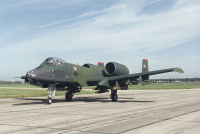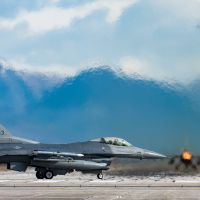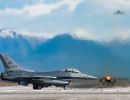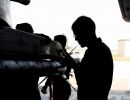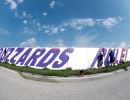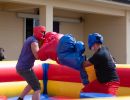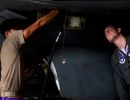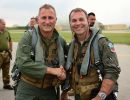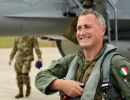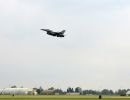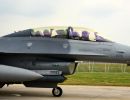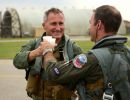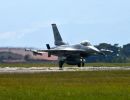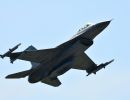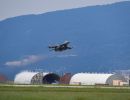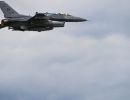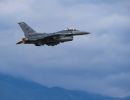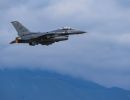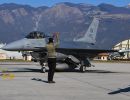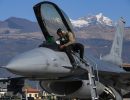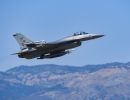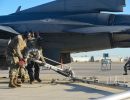The A/OA-10 aircraft was specifically developed as a close air support aircraft with reliability and maintainability as major design considerations. The Air Force requirements documents emphasized payload, low altitude flying capability, range and loiter capability, low speed maneuverability and weapons delivery accuracy. The A-10 is slow enough to be an observation plane. This greatly increases the A-10's effectiveness at protecting ground troops.
The A/OA-10 is a single place, pressurized, low wing and tail aircraft with two General Electric TF-34-100/A turbo-fan engines, each with a sea level static thrust rating of approximately 9000 pounds. The engines are installed in nacelles mounted on pylons extending from the fuselage just aft of and above the wing. Two vertical stabilizers are located at the outboard tips of the horizontal stabilizers. The forward retracting tricycle landing gear incorporates short struts and a wide tread. The nose wheel retracts fully into the fuselage nose. The main gear retracts into streamlined fairing on the wing with the lower portion of the wheel protruding to facilitate emergency gear-up landings.
The A-10's survivability in the close air support arena greatly exceeds that of previous Air Force aircraft. The A-10 is designed to survive even the most disastrous damage and finish the mission by landing on an unimproved airfield. Specific survivability features include titanium armor plated cockpit, redundant flight control system separated by fuel tanks, manual reversion mode for flight controls, foam filled fuel tanks, ballistic foam void fillers, and a redundant primary structure providing “get home” capability after being hit.
All of the A-10's glass is bulletproof and the cockpit itself is surrounded by a heavy tub of titanium. Titanium armor protects both the pilot and critical areas of the flight control system. This titanium "bathtub" can survive direct hits from armor-piercing and high explosive projectiles up to 37mm in size. The front windscreen can withstand up to a 23mm projectile. Fire retardant foam protects the fuel cells which are also self sealing in the event of puncture.
The redundant primary structural sections allow the aircraft to enjoy better survivability during close air support than did previous aircraft. Designers separated all of the crucial battle and flight systems. The wheels can roll in their pods, which lets the plane perform belly landings without significant damage to the aircraft. Dual engines are mounted away from the Warthog's fuselage; if one is destroyed, the other can propel the craft to safety. Dual vertical stabilizers shield the hot exhaust from Russian-designed heat seeking missiles. The A-10 has two hydraulic flight control systems, backed up by a manual flight control system. This redundancy allows the pilot to control a battle damaged aircraft, even after losing all hydraulic power. Furthermore, redundant primary structural and control surfaces enhance survivability. Lastly, the long low-set wings are designed to allow flight, even if half a wing is completely blown off. No other modern aircraft -- including the F-16 -- can survive such punishment. The wings themselves are set low to allow for more weaponry to fit beneath the aircraft.
The General Electric Aircraft Armament Subsystem A/A49E-6 (30 millimeter Gun System) is located in the forward nose section of the fuselage. The gun system consists of the 30mm Gatling gun mechanism, double-ended linkless ammunition feed, storage assembly and hydraulic drive system. The General Electric GAU-8/A 30mm seven barrel cannon, specifically designed for the A-10, provides unmatched tank killing capability. The gun fires armor-piercing projectiles capable of penetrating heavy armor. It also fires a high explosive incendiary round, which is extremely effective against soft skinned targets like trucks. The cannon fires at a rate of 4,200 rounds per minute. The A-10's maneuverability, teamed with the gun's accuracy, allows the pilot quick reaction with lethal effects. Other weapons include the AGM-65 Maverick and AIM-9 Sidewinder missiles.
Thunderbolt IIs have Night Vision Imaging Systems (NVIS), compatible single-seat cockpits forward of their wings and a large bubble canopy which provides pilots all-around vision. The ACES-II ejection seat safely operates from 518 miles per hour down to zero speed and zero altitudes.
Avionics equipment includes communications, inertial navigation systems, computer-aided fire control and weapons delivery systems, electronic countermeasures, target penetration aids and self-protection systems. The A-10 employs both electronic and infrared countermeasures against enemy weapons systems. The weapons delivery system incorporates a heads-up display that provides the pilot with references for flight control and weapons employment. The weapons delivery systems include head-up displays that indicate airspeed, altitude and dive angle on the windscreen, a low altitude safety and targeting enhancement system (LASTE) which provides constantly computing impact point freefall ordnance delivery; and Pave Penny laser-tracking pods under the fuselage.
General characteristics:
* Crew: 1
* Length: 53 ft 4 in (16.26 m)
* Wingspan: 57 ft 6 in (17.53 m)
* Height: 14 ft 8 in (4.47 m)
* Wing area: 506 ft² (47.0 m²)
* Airfoil: NACA 6716 root, NACA 6713 tip
* Empty weight: 24,959 lb (11,321 kg)
* Loaded weight:
o Standard: 30,384 lb (13,782 kg
o On CAS mission: 47,094 lb (21,361 kg)
o On anti-armor mission: 42,071 lb (19,083 kg))
* Max takeoff weight: 50,000 lb (23,000 kg)
* Powerplant: 2× General Electric TF34-GE-100A turbofans, 9,065 lbf (40.32 kN) each
Performance:
* Never exceed speed: 450 knots (520 mph, 830 km/h)
* Maximum speed: 380 knots (438 mph, 704 km/h) at 5,000 ft (1,500 m) with 6 Mk 82 bombs
* Cruise speed: 300 knots (340 mph, 560 km/h)
* Combat radius:
o On CAS mission: 250 nm (288 mi, 460 km) at 1.88 hour single-engine loiter at 5,000 ft (1,500 m), 10 min combat
o On anti-armor mission: 252 nm (290 mi, 267 km), 40 nm (45 mi, 75 km) sea-level penetration and exit, 30 min combat
* Ferry range: 2,240 nm (2,580 mi, 4,150 km) with 50 knot (55 mph, 90 km/h) headwinds, 20 minutes reserve
* Service ceiling: 45,000 ft (13,700 m)
* Rate of climb: 6,000 ft/min (30 m/s)
* Wing loading: 99 lb/ft² (482 kg/m²)
* Thrust/weight: 0.36
Armament:
* Guns: 1× 30 mm (1.18 in) GAU-8/A Avenger gatling gun with 1174 rounds
* Hardpoints: 8× under-wing and 3× under-fuselage pylon stations holding up to 16,000 lb (7,200 kg) and accommodating:
o Mark 82, Mark 83, and Mark 84 general-purpose bombs or
o Mk 77 incendiary bombs or
o BLU-1, BLU-27/B Rockeye II, Mk20, BL755[citation needed] and CBU-52/58/71/87/89/97 cluster bombs or
o Wind Corrected Munitions Dispenser (A-10C) or
o GBU-10 Paveway II, GBU-12 Paveway II, GBU-16 Paveway II and GBU-24 Paveway III laser-guided bombs or
o Joint Direct Attack Munition (A-10C)[13] or
o AGM-65 Maverick air-to-surface missiles and AIM-9 Sidewinder air-to-air missiles or
o LAU-68 Hydra 70 mm (2.76 in) and 127 mm (5.0 in) rocket pods or
o Illumination flares, ECM and chaff pods or
o ALQ-131 ECM pod or
o LITENING AT/Sniper XR targeting pods (A-10C)

